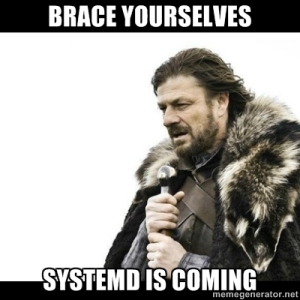
We started to roll out systemd today.
But don’t panic! Your system will still boot with openrc and everything is expected to be working without troubles.
We are aiming to support both init systems, at least for some time (long time I believe) and having systemd replacing udev (note: systemd is a superset of udev) is a good way to make systemd users happy in Sabayon land. From my testing, the slowest part of the boot is now the genkernel initramfs, in particular the modules autoload code which, as you may expect, I’m going to try to improve.
Please note that we are not willing to accept systemd bugs yet, because we’re still fixing up service units and adding the missing ones, the live media scripts haven’t been migrated and the installer is not systemd aware. So, please be patient 😉
Having said this, if you are brave enough to test systemd out, you’re lucky and in Sabayon, it’s just 2 commands away, thanks to eselect-sysvinit and eselect-settingsd. And since I expect those brave people to know how to use eselect, I won’t waste more time on them now.
Let me guess, it is our “modprobe all those modules”-logic?
I think we should configure the big-ass (all 14k bigger) version of modprobe in busybox, and just
busybox find /sys -iname modalias -exec busybox sh -c ‘busybox modprobe -q “$(cat “{}”)”‘ ‘;’
That actually works, but needs to be adjusted as if you replace the current logic nothing loads filesystem modules.
That would actually also fix some bugs, one of my desktops used at least to hang during genkernel on livecds as it loaded a module my system did not use, and really did not like.
>> From my testing, the slowest part of the boot is now the genkernel initramfs
Is this needed ? I removed it and compiled kernel with ext4 build-in kernel.
Pingback: Sabayon: systemd anche per la distro italiana | oneOpenSource
Pingback: Sabayon pronta per systemd. | ItaliaUnix Blog
Interesting. Both Arch Linux and distributions using Dracut (Fedora, Mageia, openSUSE…) are moving to systemd driven initramfs. Any chance that Sabyon might support that too? It should be very fast too.
Feel free to ping me if you are interested in getting systemd working in your initramfs. Dracut has moved to that, and we expect to be able to do the same in Arch RealSoonNow.
We have had reports of initramfs with systemd now booting faster than no initramfs at all [1] (i.e., using a kernel with the modules built-in), so the major argument against having an initramfs (that it slows down boot) is no longer true 🙂
[0]: https://plus.google.com/116442056808259194967/posts/bXNaMipzY5w
[1]: https://plus.google.com/114015603831160344127/posts/RtPgrezU6Cy
[2]: https://plus.google.com/108087225644395745666/posts/H9CFBQLG8S8
Hey Tom, yeah, now that I successfully rolled out systemd, I would be very interested in moving to dracut. Are you on freenode?
@lxnay: yeah, I (tomegun) can usually be found on #systemd. I have been working on adding systemd to our own initramfs rather than using dracut, but if you want to use dracut you should probably speak with Harald Hoyer (haraldh).